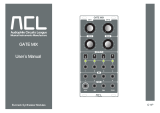
6
OVERVIEW
OPTOMIX is a two-channel Low Pass Gate that utilizes 4 vactrols in order to provide simultaneousvoltage-control over the
Amplitude and Frequency content of a signal. It is in essence, a VCF-A (VoltageOPTOMIXSUMming stage, complete with an
AUXiliary INput allowing for the chaining of multiple units to create larger mixes (this also works well in combination with the
modDemix).
The new OPTOMIX has the same sound and original feature set, save for one Normalization: CHannel 1 Signal OUTput is no
longer Normalled to the CHannel 2 Signal INput. What we have added is the ability to allow OPTOMIX to be used as an Audio
Compressor or CV Processor/Generator.
The DAMP parameter, unique to OPTOMIX, allows the artist to ProGraM the way the Low Pass Gateresponds to a decaying
control transient, such as an Envelope signal generated by MATHS or a Gateapplied to a CHannel’s STRIKE INput (see below).
DAMP is continuously-variable, allowing anything from a long, slow, ringing to a short, fast, and muted response.
The STRIKE INput allows the artist to use a typical 8V Gate signal to trigger the LPG (Low Pass Gate) circuit by “plucking” or
“striking” the vactrol, thus allowing it to impart its magically-slow response time to the Amplitude of the signal being processed
(this concept is also featured on the Make Noise DPO, MMG, LxD, and RxMx). Combined with the DAMP parameter, STRIKE
allows for the programming of percussive sounds(i.e. sharp Attack with Voltage-Controlled Decay) without the need for a
Voltage-Controlled Envelope Generator.
As a VCA, OPTOMIX has a moderate Attack response and slow Decay response, meaning that it turns onsound that is dynami-
cally processed. Folks have often described the sound as “ringing,” and while the circuit is not technically ringing, that does
describe many of the sounds possible when using a LPG such as the OPTOMIX in order to process complex signals generated
through FM or Ring Modulation.
As a VCF, it is a mild, non-resonant Low Pass circuit acting to gently reveal (or hide) the sharper edges of asimultaneous loss in
high frequency content that is similar to the natural loss of energy in idio and membranophonic instruments.
PERSPECTIVE
OPTOMIX, being a vactrol-based circuit, will never have the speed or tight tolerances found in many otherVCA and VCF circuits.
I would recommend that musicians desiring closely matched gain across multiplechannels of VCAs look elsewhere! If you seek
to ProGraM extremely short sounds, clicks, pops and ticks, OPTOMIX is not the best choice. What OPTOMIXsmooth, natural
sounding circuit.













